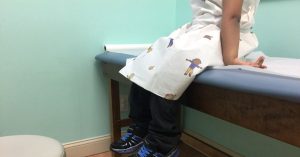Call for your appointment today 914-666-4665 | Mt. Kisco, New York

Individuals who suffer from persistent symptoms may be diagnosed with a post-treatment lyme disease syndrome or ‘chronic Lyme disease.’ Studies estimate that between 34% and 62% of patients continue to have ongoing, chronic symptoms even after standard antibiotic therapy. Many remain ill for months to years. In fact, according to one study, 34% of a population-based, retrospective cohort were still ill an average of 6.2 years after antibiotic treatment.
Additionally, four clinical trials, sponsored by the National Institutes of Health (NIH), demonstrated the potential seriousness of Lyme disease. According to the findings, the quality of life for chronically ill patients “was equivalent to that of patients with congestive heart failure; pain levels were similar to those of post-surgical patients and fatigue was on par with that seen in multiple sclerosis.”
In his editorial, “Post-treatment Lyme disease syndromes: distinct pathogenesis caused by maladaptive host responses,” Steere concedes that patients can remain seriously ill. “These patients may have severe pain around joints (tender points), headache, brain fog, sleep disorder, and incapacitating fatigue, which have a major impact on the quality of life.”
“Physicians are often in a quandary regarding whether these patients still have active infection or postinfectious phenomena,” he writes.
Unfortunately, Steere dismisses the hypothesis that a persistent and active infection could be causing ongoing illness in patients with ‘chronic Lyme disease’ or post-treatment Lyme disease syndrome, as he claims, there is a “current lack of evidence of persistent infection or antibiotic efficacy in human patients with PTLDS.” (A statement which I dispute.)
Instead, he has developed and proposes that patients suffer from various post-infectious syndromes, which include:
Post-infectious Lyme arthritis
“Massive inflammatory, synovial proliferation usually affecting a knee, emerging from Lyme arthritis.”
Pathogenesis: Excessive pro-inflammatory immune response with high IFN-γ levels persistent in the post-infectious period, blocking appropriate wound repair processes.
Post-treatment Lyme disease syndrome
“Pain, neurocognitive, and fatigue symptoms emerging after any LD [Lyme disease] manifestation.”
Pathogenesis: Increased sensory signals during infection do not reset appropriately after infection, called ‘central sensitization syndrome.’
Autoimmune joint disease
“Rheumatoid arthritis, psoriatic arthritis, or peripheral spondyloarthropathy emerging after any LD [Lyme disease] manifestation.”
Pathogenesis: Adjuvant effect of infection activating latent autoimmune disease.
Autoimmune neurologic disease
“Chronic idiopathic demyelinating polyneuropathy emerging from Lyme radiculoneuropathy.”
Pathogenesis: Unknown.
Steere points out, that individuals with systemic autoimmune diseases following Lyme disease may benefit from immunosuppressive or anti-inflammatory therapy.
He concludes, “disabling posttreatment syndromes may still develop, which appear to result primarily from disadvantageous or maladaptive host responses to the infection that persist after spirochetal killing with antibiotics.”
Editor’s note: I do not agree with Dr. Steere’s position. And for transparency purposes, I’m an author of the International Lyme and Associated Diseases Society (ILADS) guidelines, which does not dismiss the persistent infection hypothesis but supports ongoing antimicrobial treatment until Lyme disease symptoms resolve.
Related Articles:
Case report: Persistent pain and fatigue following treatment for Lyme disease
Borrelia spirochete are masters at evading the immune system
References:
- Steere AC. Posttreatment Lyme disease syndromes: distinct pathogenesis caused by maladaptive host responses. J Clin Invest. 2020;130(5):2148-2151.




Question about the use of “post-treatment” language. Do these syndromes apply only to those who were treated while in acute phase? Or to anyone post-acute? For example, in my case, my bite was confirmed many years after the fact, and I had never had treatment, but certainly have post-acute-stage issues. In other words, are the syndromes above truly related to the typical treatments applied during acute stage, or to the Lyme infection itself?
I am not a fan of the term “post-treatment” as some doctors assumed there is no evidence of persistent infection. Some have used the term if symptoms persist after 3 weeks of antibiotics.
Ok, are you saying that these 4 syndromes are really post-infection, and not related to the treatment itself? But using the “post-treatment” label out of convenience. What I’m trying to understand is whether these syndromes result from the treatment or result from the infection.
They four syndromes are from the infection. The doctor assumes the infection has cleared.
I have had lyme doxi treatment numerous times over last few years. I now have a painful 2.5 cm lump in a groin lymph node. The lyme test shows prior lyme infections. Have you seen lymphoma from lyme after treatment? My primary thinks I push a lyme diagnosis too much as the root cause of fibromyalgia and brain fog.
I have not seen Lymphoma after treatment for Lyme disease. You need to see a doctor, i.e. surgeon or oncologist for an evaluation. I have patients with both Lyme disease and cancer. I have had to treat their Lyme disease along with their oncologist. Call my office at 914 666 4665 if you have any questions.
Does your pcp have any other ideas .. what’s wrong with treating your symptoms … just don’t bundle everything into one diagnosis because those words, chronic Lyme can bring a shit storm down on the the pcp’s head … I have the same issues as you do plus post sepsis syndrome which gets the same treatment .. they seem more open to post Covid symptoms which appear to be similar to both post Lyme and post sepsis .. they all three share massive inflammation as a common thread .. perhaps the post Covid issues will drive research that could help us all
Dr Cameron, in addition to (or apart from) borrelia/lyme infections, have you found other bacteria to be “persistent” such as Tularemia, Bartonella, Brucella and Babesia? Thank you sir,
I am not sure any one has looked at other infections.
The doc I’m seeing to treat Lyme put me on clarithromycin and cefuroxime twice a day . No length of treatment but provided 30 day supply with 1 refill. Unable to call MD to ask if I take it 30 or 60 days. Any thoughts? His office reopens 1/4/2021
1/4/21 is nearly here. I would typically extend therapy few a days until I could make an appointment for a reassessment. I cannot comment on your treatment.
Using a 2014 study to support his theory with 36 patients and one-third of them being his control group? Most others references were all based on his lunacy. I get so angry thinking anyone pays attention to the likes of this “Physician”. I was diagnosed 20 years ago in Ct. Although I was treated well by some of the best ILADS Doctors- I am living proof That Chronic LD exists. Ten years of remission and poof- gone in a minute! There was little or no testing for co-infections back then although I was treated for two of them for a while. Treatment options are near impossible having moved to a Southern State that denies LD exists here. Thank you for all your work Dr. Cameron. he best I can offer is to educate others so they learn and seek treatment soon!